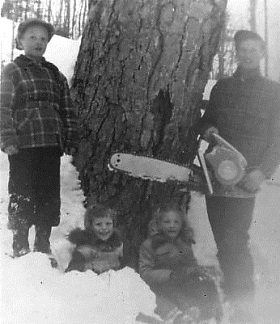Bancroft Area Forest Industry Association
History
..of the Forest Industry in Hastings County
Before the chainsaw…
Forestry in the Bancroft area dates back prior to the 1900’s. The lumbering was done mainly in the winter months with cross cut saws and horses for skidding. Horse and sleighs hauled out the timber to railway sidings or to rivers where logs were transported by train or driven down the rivers to sawmills. The timber that was cut was high quality hardwood and softwood, leaving the low quality trees in the woods. This was done because there weren’t any markets for the low quality wood.
Some of the companies that were in place in the early 1900’s were McCrae Lumber in Whitney, Murray Bros in Madawaska, and Chisholm Lumber in Roslin. In the mid 1900’s these companies were still running in addition to Martin Lumber in Harcourt, Jan Lumber in L’amble, Freymond Lumber in Bancroft, and Goodman Lumber in Maynooth.
 Changing times…
Changing times…
In the early 1960’s the use of horses started to fade out and new equipment such as skidders and bulldozers came on to the scene. The crosscut saw was replaced by the chainsaw. By the 1970’s tree marking started on crown land and on some private lots. By mid 1960’s the markets for low quality logs and sawmill residues was being developed for the pulp and paper industry and the board industry. The markets for low quality wood products helped to improve the forest practices in the woods and the cutting became more stringent. The marking practices changed which allowed for the removal of poor quality trees while leaving a higher quality stand.
The demand for wood products from the 1970’s till now has been up and down with the peak times very good and the valleys sometimes disastrous.
The future is bright for our industry…
Forest management keeps improving as the markets expand and experience and knowledge is gained and practices on Crown land are used on private land. Our forest quality is improving with sound and sustainable forest practices and the use of mechanized harvesting, which helps with compliance and safety in the woods. The wood processing facilities are using everything in the tree with the help of technology which helps us compete in the world market. Our proximity to southern Ontario coupled with good forest management is a distinct advantage for our products which we intend to build on.
The majority of the businesses mentioned above still operate to this day, giving evidence to the strong roots and relationships that have been established within the community by the forest industry. Our persistence over the years has given us the ability to understand, adapt and influence the cultural, ecological and economic challenges that face our industry, now and into the future.
Source: http://bafia.ca/history